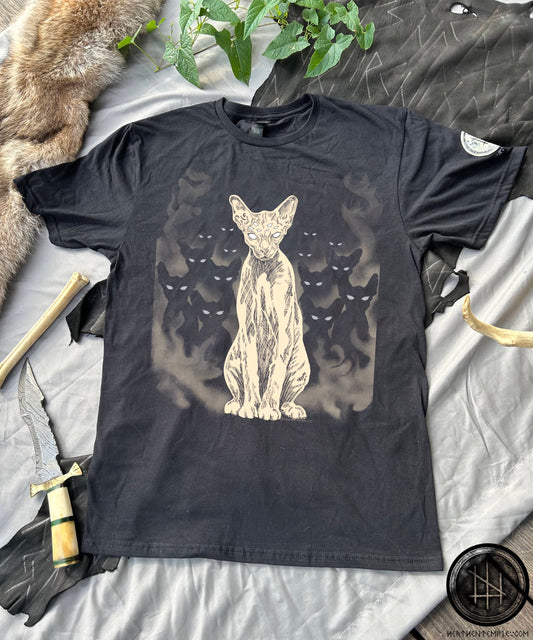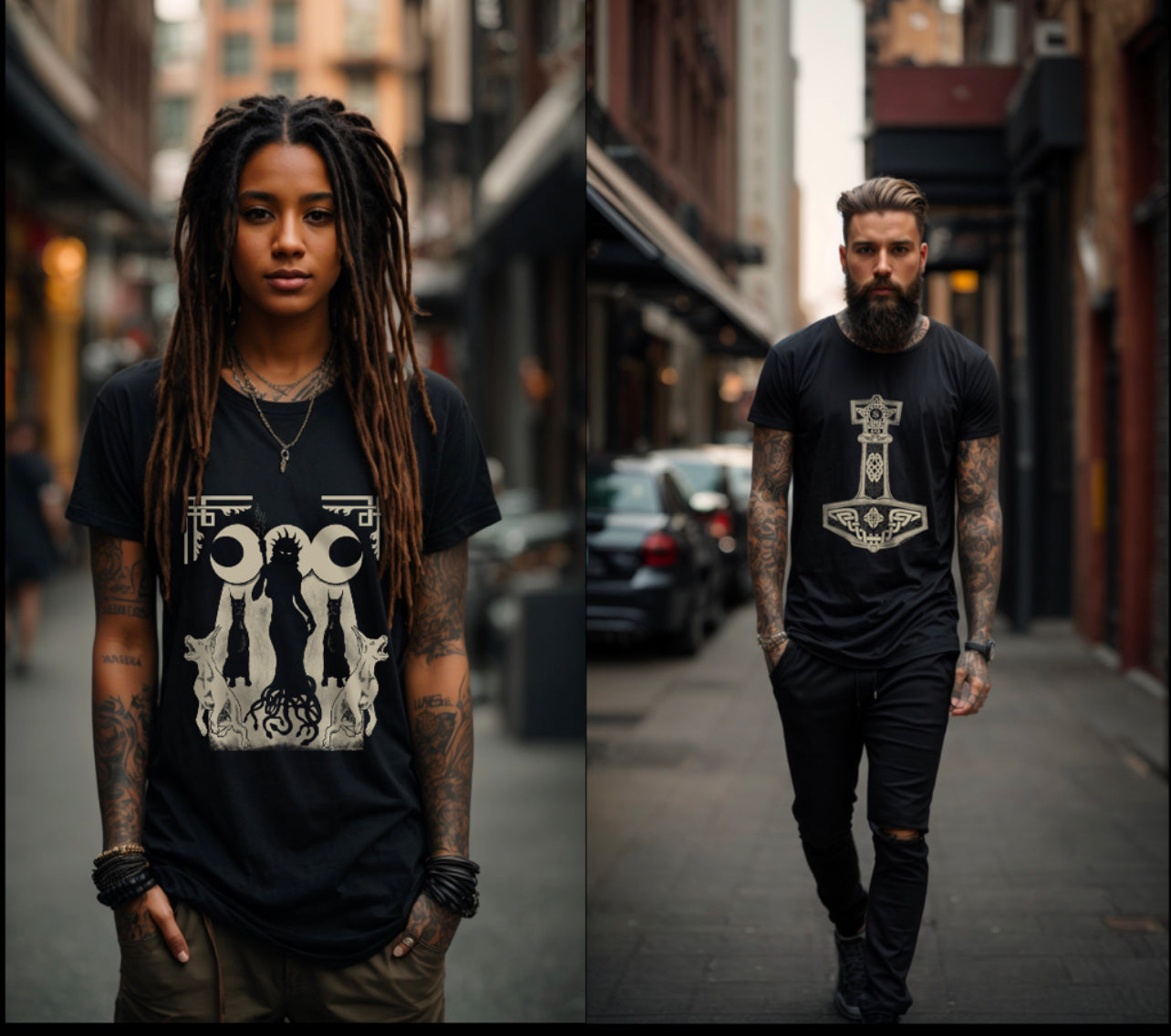Hel doesn’t want your worship—she wants your truth.
In a world obsessed with light, beauty, and sanitized death, Hel stands as a stark reminder of everything we bury—literally and metaphorically. She doesn’t knock. She doesn’t roar. She waits. Half-beautiful, half-decayed, Hel is the daughter of Loki and the keeper of those who die unloved, unremembered, or not in glory. You won’t find her in the mead halls of Valhalla or the warm, fertile embrace of Freyja’s fields. She rules cold soil and honest endings.
And in a world addicted to pretending death doesn’t exist, Hel is more alive than ever.
Who Is Hel?
Hel is one of the most misunderstood deities in the Norse pantheon—and that’s saying something.
Born of the trickster Loki and the jötunn Angrboda, Hel is the sister of Fenrir (the wolf fated to devour Odin) and Jörmungandr (the world serpent). She was cast into Niflheim by Odin himself, who saw her power as dangerous and unfit for the realm of the gods. There, she rules over the dead who do not die in battle—those who pass of illness, age, misfortune, or quiet tragedy.
Her realm is Helheim, often mistaken for a Norse version of Hell. It’s not. There is no burning fire, no judgment of sin. Only inevitability.
And that’s where the power lies.
Hel is a goddess of necessity, not punishment.
She receives.
Her Appearance: The Half-Living Queen
Hel is often depicted as being half living flesh, half corpse—one side vibrant and beautiful, the other rotted, pale, or skeletal. It’s not just shock value. It’s truth: She embodies the full spectrum of death. Dignity and decay. Memory and oblivion. Transition and permanence.
Some see her as horrifying. Others see her as comforting. Both reactions are valid—and both say more about the living than the dead.
This duality is important. In the ancient world, Hel was not a monster. She was a keeper of balance. The Norse didn’t sanitize death. They understood it was part of the cycle. Hel was an ending that made way for rebirth.
That’s what makes her so powerful today.
Hel in Pagan Spirituality: More Than a Death Goddess
In modern pagan practice, Hel represents much more than a ruler of the dead. She stands as a symbol of:
- Shadow work
- Grief processing
- Acceptance of mortality
- Transformation through decay
- Spiritual sovereignty
Hel doesn’t demand sacrifice or adoration. She asks for honesty. Brutal, unflinching honesty about what you’ve lost, what you’re hiding, and what you fear most. In this way, Hel becomes not just a goddess of death, but a goddess of revelation.
In many ways, she is the spiritual embodiment of winter—cold, still, yet essential for life to reset and begin again.
Those doing inner alchemy or walking through grief often find Hel standing quietly beside them, not taking away the pain, but witnessing it. Holding space for it. Not flinching.
Hel vs. the Christian Hell: Let’s Set the Record Straight
Let’s get one thing very clear: Hel is not Hell.
The Christian idea of Hell—a place of eternal torment for sinners—is a separate concept entirely. The name similarity is coincidence, not correlation. Hel’s domain is neutral, not evil. It’s not a place of punishment, but of return.
In Helheim, there is no fire and brimstone. There’s mist, stillness, and memory. If anything, it’s closer to the ancient idea of Hades—a shadow realm, necessary but uncomfortable for those who cling to life.
If you’ve been raised in a tradition where death is inherently a punishment, Hel breaks the spell.
Working With Hel: What She Demands (and Doesn’t)
Hel isn’t a goddess who responds well to flattery or hollow rituals.
If you want to honor her, do so in truth:
- Tend graves. Especially those forgotten by others.
- Remember the lost. Speak their names.
- Face your shadows. Sit with the parts of yourself you’d rather not see.
- Burn the masks. Show up as you are, not as you pretend to be.
Offerings to Hel often include bones, black stones, dried flowers, or art depicting decay and rebirth. But the greatest offering is authenticity.
You can’t lie to the dead. Hel sees through everything. She does not punish—but she will not be fooled.
The Silent Power of Stillness
We’re constantly told to move faster. Grow. Rise. Accelerate.
Hel reminds us of the sacredness of stillness.
In Helheim, there is no ticking clock. No performative healing. Only presence.
When you sit with Hel, you’re not being asked to fix yourself. You’re being asked to stop running. To look death in the eye—not as an end, but as an invitation to understand what actually matters.
This is why many practitioners experience Hel as a goddess of deep wisdom. She doesn’t speak loudly, but her silence carries weight. And when she does speak—through dreams, signs, or sacred quiet—it’s not comfort. It’s clarity.
Hel in the Modern World
In today’s world of spiritual bypassing, false positivity, and love-and-light-only practices, Hel is a radical force.
She doesn’t wear glitter. She doesn’t promise salvation. She doesn’t coddle. But she does liberate.
Liberate you from false ideals.
From performative grief.
From fear of the inevitable.
In Hel’s embrace, there is no shame in sadness. No shame in slowness. No shame in scars.
She is for the outcast, the forgotten, the ones who died screaming or weeping or fading away alone. She is for the ones who live carrying death inside them. And she’s also for the ones doing the deep, hard work of reclaiming themselves from the ruins.
Hel is not a comfortable goddess.
But she is a necessary one.
Hel and Heathen Temple
At Heathen Temple, Hel isn’t a footnote. She’s a pillar.
We honor her as a reflection of shadow work, spiritual endurance, and the courage to face both beauty and rot. When we create art, apparel, or limited edition drops around her image, it isn’t for edginess. It’s for truth.
Our depictions of Hel embrace that duality—sometimes sensual, sometimes skeletal, sometimes both. Because death has many faces. And so does rebirth.
She is honored not just with imagery, but with intention.
When you wear Hel, you’re not just wearing death. You’re wearing honesty. You’re invoking the right to rest, to grieve, to shed the illusion of perfection and stand sovereign in your own skin.
Final Thought:
To honor Hel is to honor the parts of you you’ve buried.
The ones who never got closure.
The ones who died quietly inside you.
The ones still waiting to be acknowledged.
In doing so, you don’t become less. You become whole.
Hel doesn’t ask you to be fearless. She asks you to be real.
And in that realness, there is power.



